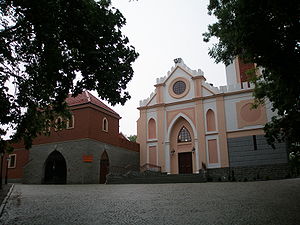Gostynin [g?s't??in] (German: Waldrode) is a town in Central Poland with 19,414 inhabitants (2004). It is situated in the Masovian Voivodship since 1999 and was previously in the Plock Voivodship from 1975 to 1998. It is the capital of Gostynin County.Gostynin has a long and rich history, which dates back to the early Middle Ages. In the 6th century, a Slavic gord existed north of contemporary town, on a hill located on the left bank of the Skrwa Lewa river, along a merchant trail. In the 12th century, the settlement found itself near the border between the provinces of Mazovia and Kujawy. In c. 1240, Gostynin was expanded by Duke Konrad I of Masovia, and in the 1280s, Duke Boleslaw II and Duke Konrad II fought over control of the settlement. As a result, in 1286 it was burned by Konrad II. Quickly rebuilt, in 1300 Gostynin was besieged but not captured by forces of Wenceslaus II of Bohemia. In c. 1326, the gord was besieged by Wladyslaw Lokietek, who wanted to control the area of Plock, which was a Bohemian fief. By early 1300s, Gostynin emerged as an important administrative center of Mazovia. In 1329, it became the seat of a castellan; first known castellan was a man named Pawel, mentioned in a 1345 document. In 1352, Siemowit III for the first time used the title ?Duke of Gostynin?. It was probably during his reign that a defensive castle with a tower was built. At that time, a new settlement was established on the right bank of the Skrwa Lewa river, with a market square and a new parish church of St. Martin. In 1382, Duke Siemowit IV granted town charter to Gostynin, and as a result, ancient gord, located on the left bank of the river declined. Siemowit IV expanded the castle, making it his favorite residence. Wladyslaw Jagiello visited Gostynin twice (1414, 1419). Siemowit IV died here in 1426, and after his death, the complex was rebuilt, with a wooden chapel added to it in 1439.After childless deaths of two last dukes of Plock (Siemowit VI) and Wladyslaw II of Plock, in 1462 Gostynin?s residents welcomed King Kazimierz Jagiellonczyk, who confirmed all town?s privileges, and attached it to the Kingdom of Poland. From 1462 until 1793, Gostynin was part of Rawa Voivodeship, in which it was the seat of both a Land, and a county. Gostynin continued to prosper - in the period known as the Polish Golden Age, it had 265 houses, inn, mills and a brewery (as for 1564). In 1612, Russian Tsar Vasili IV died at the Gostynin castle, in which he had been kept with two brothers since 1611.The period prosperity ended during the Swedish invasion of Poland (1655 - 1660), after which only 20 houses were left in the whole town. Gostynin never recovered: it was burned by Russians in 1772, during Bar Confederation, and in 1777, the number of houses was only 43. By 1797, Gostynin had 89 houses, three churches, inn, brewery, three mills, sawmill and a wooden town hallIn 1793, following the second partition of Poland, Gostynin was captured by Prussian army. The castle, which had for long time been neglected, was pulled down, and its archive was seized by the occupiers. In 1807 - 1815 Gostynin belonged to the Duchy of Warsaw; in 1809, most of the town burned in a great fire. In 1824, the government of Russian-controlled Congress Poland invited to Gostynin 124 German cloth makers, who came with their families. The town began the process of recovery: St. Martin church, town hall and inn were rebuilt, and ruins of the castle were turned into a Protestant church. During the January Uprising, a rebel unit of Emeryk Syrewicz operated in the area of Gostynin. The town had a significant Jewish minority, which in the Second Polish Republic numbered some 2,000, out of total population of 12,000. In 1924-25, Gostynin received rail connection with Plock and Kutno, thanks to a newly built line.On September 16, 1939, Gostynin was captured by the Wehrmacht, and by late September, the town was directly annexed to the Third Reich. Its name was first changed into Gasten, and since June 1941 until the end of German occupation, it was called Walrode. German authorities opened here a Jewish ghetto, most of whose residents were murdered in Chelmno. Germans retreated from Gostynin on January 18, 1945; the town was destroyed in 15%.

Titulo del líder
Mayor
Población total
19119
Huso horario
Central European Time



Aipatu
0